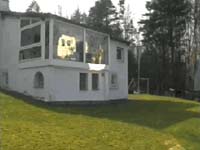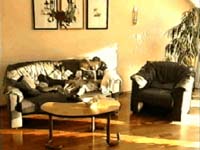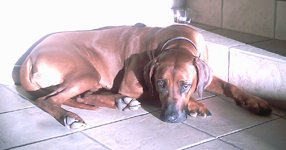What is the meaning of "Heliostat"?
The term "Heliostat" has its origin in the astronomical science and circumscribes the technique required to track moving stars (especially the sun, Greek: helios) with an astronomical telescope automatically.
Which physical principle is used with the Heliostat?
"Light-coming-in-angle equals light-falling-out-angle".
Wherefore an Heliostat is used?
A Heliostat is deflecting sunlight permanently into dark corners and into the depth of buildings using a mirror.
From which parts a Heliostat is compounded?
The Heliostat in effect consists out of three constructional- und functional groups: The reflector (mirror), the twin-axis-rotor, which holds and moves the mirror, and a computer with an astronomical program.
- The reflector is a facade-flat-mirror, whose particularity is the high surface planarity.
- The special performance of the twin-axis-rotor comes from the high tracking accuracy and the ability to suffer high wind loads.
- The control and compute unit contains, beside an astronomical program, a clock with calendar and the Kepler-data of the earth and of the sun.
Which reflector sizes and designs are actually available?
- 0.8 m2 reflecting area – 1.0 m Ø round
- 1.8 m2 reflecting area – 1.5 m Ø round
- 3.0 m2 reflecting area – 1.5 m x 2.12 m octogonal
- 5.5 m2 reflecting area – 2.45 m x 2.45 m octogonal
Where is the outdoor unit to be positioned (reflector and rotor)?
The outdoor unit (rotor with mirror) preferably is positioned north of the target-point. If the position is north-western from the target-point the more the morning sun and less the setting sun can be utilized. If the position is north-eastern from the target you will get more setting sun and less morning sun.
Which cable length or distance can be accepted between rotor and control unit?
max. 200 m!
How many wires are used to make the connection between rotor and control unit?
10 x 0.6 mm2 (telephone cables) and 4 x 1.5 mm2 (mains cable)
How fast and how often the mirror is moving?
Respectively after about 1/10th degrees sun-progress (approx. about 20 sec. of time) the two integrated motors are activated in such a manner, that the offset of the reflex is back-corrected. Thereby the runtime of the motors lasts about 1/10th second only! After that, the system waits for 20 seconds again. If the sunset is reached in the evening, the rotor turns the mirror into a position, which had been determined by the operator of the installation before and stops there till sun-rise.
How far remote from the target the Heliostat can be mounted?
It had already been mounted only in a distance of 4 m from the target. That is very close and the contours are very sharp. Theoretically nearer distances are still possible. Thereby it may happen, that the target throws a shadow onto the Heliostat. More interestingly is the placement in higher distances: The good planarity of the reflector and the high precision of the drive permits to place the rotor/mirror-unit up to about 200 m (!) away from the target-point, however depending from the target-size. The advantage of this characteristic is the ability, to hide the Heliostat deep in the background and not to disturb the aesthetic actualities at the location. In the same way it is possible to conduct sun-light deep into buildings. In a 100 m distance 20 seconds progress of the sun corresponds to about 20 cm reflex-offset!
What is the projection area of the mirror?
If the sunrays dip vertically onto the mirror, the outlines of the reflection equal – approximately – the mirror-size. If the sunrays fall in onto the mirror from the side with flat angles, the reflex-size reduces itself to the projection area of the mirror. If the sunlight is turned around exactly by 90 degrees, the yield is reduced about a factor of 0.7. So, e. g., from a round mirror an oval reflex with an according reduction will result.
Will the Heliostat spread the light or will it be bundled?
Due to the dimensions of the sun-disk (aperture about 0.6 degrees) and due to inaccuracies of the mirror a dispersion of sun light will result: In a distance of 100 m the reflex spreads out – with flat reflection – enlarging the lighted area with a factor about 1.5 of the mirror-size.
How can I bring the light onto another target?
Because the system is allowing up to 50 targets to be pre-programmed by the user of the installation, by an easy push on a key diversions can be directed onto any other "sun-light-demand-areas", including: kitchen, living room, children's room, stack window etc. Or onto outdoor areas, e. g. sitting groups, sunbeds, or children's playgrounds!
How to program a new target?
Watch the reflected sun spot and use the internal control unit, drive the reflex onto the new target – using the 4 keys "Up", "Down", "Right" or "Left" – and save with a further keystroke. The number of this memory can be selected any time by pressing the resp. key.
Which type of mirrors is used?
The used mirror is – depending on which type is chosen – an aluminium mirror or a verre églomisé mineral glass mirror. Please note: The mineral glass mirrors filter out the UV part of the sunlight (regrettable or desirable?). The aluminium mirror also transfers the UV part. Both versions transfer the infrared part and thus the heat energy!
How can you imagine the quantity of light which is tracked to a target by a Heliostat?
Our four types of Heliostat are devided by their mirror sizes: with 0.8 m2, 1.8 m2, 3.0 m2 and 5.5 m2 surface. The gain of light of these systems corresponds with the gain of light of a same sized window - but which one is oriented to the sun all the time!
How can you get an impression of the light performance and effect of a Heliostat?
To figure this out please use a household mirror (for example a wardrobe mirror) and track with it – guided manually by hand – the sunlight from certain possible spots onto the target – as possible in the morning, at noon and in the evening. Just get impressed by the plenitude of light.
>>> more information on these aspects <<<
Which energy-quantity can be transported by the Heliostat?
Here some figures of the transported energy: In our degrees of latitude commonly you can expect an average sun-energy of 1000 watt peak per m2. The efficiency of the mirror used is about 85 %. If you are willing to accept a projection-reduction of F = 0.7, you can calculate with an energy-yield of about 600 watt per m2 mirror, and that in round about 1400 – 1800 hours in our degrees of latitude every year.
How will the additional energy take effect, transported – via Heliostat – into a building?
If you e. g. deflect the reflex onto an window, you will get the effects and reactions as if the sunlight gets in directly – without any deflection – but naturally with losses (by 15 – 20 %). In practice you will see, that the heaters thermostats will regulate down instantaneously – even as expected with direct sunlight.
Do windowpanes attenuate the sunlight-transmission?
Yes! However, it is the same attenuation you find with direct sunlight-transmission.
What an effect does the Heliostat and the reflected light have on fauna and flora?
Because all Heliostats are working only with planar mirrors there are neither concentrations nor scatterings resulting. You can compare the expected effects with the effects of a glass facade on a multistory building. The redirected light is usual sunlight.
What is the feeling you get from deflected sunlight?
If you are moving in deflected sunlight, you can not distinguish if you are in pure sunlight or in deflected sunlight. You will only feel the sun.
Is it possible to feel the absence of UV-light in the deflected sunrays?
No! You will get the natural good feeling of warmness, feeling well and light – just sun!
May the reflected light be dangerous?
No! All Heliostats are working only with planar mirrors. As a result of this neither there are concentrations nor scatterings. The redirected light remains sunlight further on – not diluted and not condensed.
What about the efficiency of a Heliostat?
If you know about the efficiencies of all variations of traditional solar-techniques, so you will see that a Heliostat delivers outstanding performance and efficiency (about 80 % !) not believable before. And because this efficiency is extremely good, you can afford to redirect the light once and twice or more additionally. This deflection can be performed both within the building as well outside. Usually these additional deflections can be realized with a single fixed mounted mirror. Using those mediums you get a simple way to direct the sunlight right into buildings or from above vertical into any construction.
How does the appearance of the mirror reflex look like on a facade with windows and inside the house?



>>> Click here to download a demo movie! <<<
How fast does the Heliostat reflex move from a target to another one?
Approx. 4°/sec., this means 1.4 m in 1 second at a distance of 20 m between mirror and target.
How to utilize big spots of light within buildings?
You may, e. g., direct the spot onto a black surface, where the light locally is transformed into long-waved thermal radiation. Or you may use white wall as a diffuser. Splendiferous, all the ambience around gets bright and kind (and warm just as!). Or the light will be strewn with special reflecting sheets residing within trade. The most perfect diffuser, however, is the "pearl canvas", a movie- and slide-projection-screen with really tremendous results. You must have seen this!
Wherefore is the Heliostat suitable better – for delivering light or thermal energy?
To get energy out of the unexhausted sun-resource surely is an important job for such a system. More important for us still appears the ability to deliver sunlight, nature light for work, leisure and gaming even into the deepest parts of a building, for health and wellness. These standpoint is taken in by the majority of the owners and operators of such facilities too.
What about the energy-consumption of a Heliostat?
After sun-fall and during the night till sunrise normally a standby power of 16 watts is needed, (230 V AC), just as in the 20 seconds between the individual mirror-fixes. The motors are actuated after 20 seconds respectively for only about 100 ms! For this very short period a consumption of only max. 50 watt appears. All in all much less than a small electric bulb.
Which wind loads can be survived by a Heliostat without any damage?
One of the special performances of this installation is the ability to survive at high wind loads. The 4 versions mentioned are surviving the following max. allowed wind speeds:
- 0.8 m2 reflecting area – 1.0 m Ø round — 200 km/h = 56 m/sec. = 17 Beaufort
- 1.8 m2 reflecting area – 1.5 m Ø round — 170 km/h = 46 m/sec. = 15 Beaufort
- 3.0 m2 reflecting area – 1.5 m x 2.12 m octogonal — 150 km/h = 39 m/sec. = 13 Beaufort
- 5.5 m2 reflecting area – 2.45 m x 2.45 m octogonal — 110 km/h = 30 m/sec. = 11 Beaufort
Who is installing such an installation?
Both locksmiths as well as metal-processing companies and local electricians are applicable for mounting, installation and implementing.
Is any scientific construction-accompaniment needed?
No. Only the knowledge and the capability for building up a roof-TV-antenna or e. g. a gate-drive at a garden-door is needed.
What are the characteristics of the behind glass mineral-coated flat mirror?
The used glass mirror is a mineral-coated flat mirror (DIN 1238). This type of mirrors filter out the UV portion of the sunlight (regrettable or desirable?). The infrared portion – and thus the heat energy – however is fully transferred! The mineral glass reflector has a significantly higher weight, but it is easy to clean. It has a reflection efficiency of about 85 % with a very low surface waviness. Because of the silver content of the mirror layer corrosion / aging of the mirror layer must be considered in a humid environment! Depending on the environmental conditions the effect of 'tarnishing' appears sooner or later. As you know it from traffic mirros, for example, small blunt points are formed at the beginning, which later can become areas. This mirror is subject to weather- and environment-related performance decline and aging and therefore is to be regarded as a wearing part!
What are the advantages and disadvantages of aluminium reflectors?
Aluminium reflectors are lightweight and therefore advantageous in installation and handling. In daily operation the gearing and the mechanics are prevented from damages by the low weight. Aluminium reflectors are considerably less sensitive to impact as glass mirrors are. Severe shocks may cause bumps or dents but there will be no cracks or even broken fragments.
The reflexion efficiency is high: more than 90 %! It is of some disadvantage that the cutting edges of the aluminium can subsequently corrode. We must point out that this corrosion appears only temporarily. This aluminium corrosion is some kind of 'natural anodising'. As soon as the anodic coating is thick enough (1 to 2 mm) the process dies down and the anodic coating builds a natural protective layer. You may recognize this anodic coating from a light grey area, which starts from the cutting edge and which forms a small frame around the mirror.
History
huge clockwork Heliostat
How does the deflected sun light feel?








